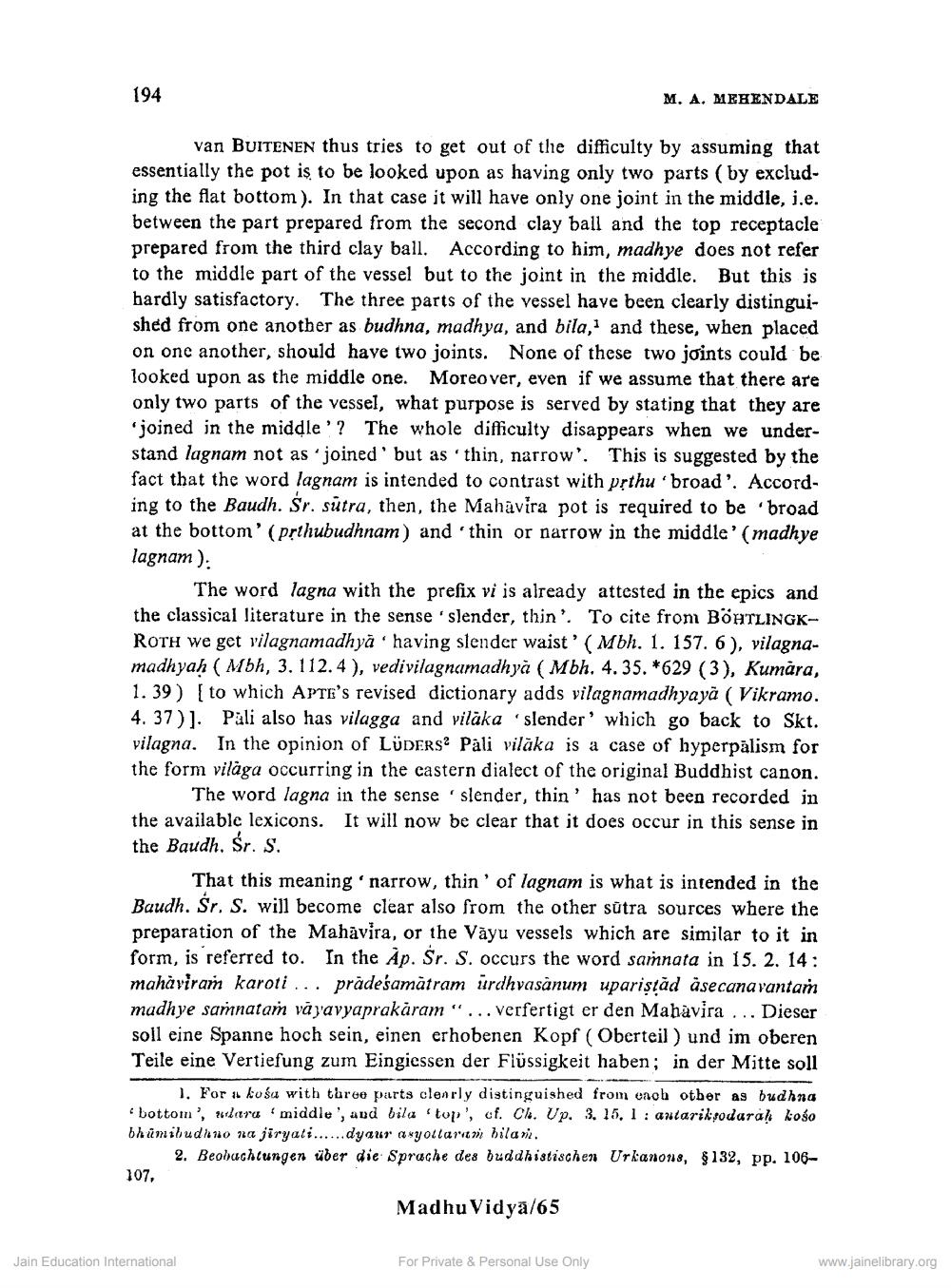________________
194
van BUITENEN thus tries to get out of the difficulty by assuming that essentially the pot is to be looked upon as having only two parts (by excluding the flat bottom). In that case it will have only one joint in the middle, i.e. between the part prepared from the second clay ball and the top receptacle prepared from the third clay ball. According to him, madhye does not refer to the middle part of the vessel but to the joint in the middle. But this is hardly satisfactory. The three parts of the vessel have been clearly distinguished from one another as budhna, madhya, and bila, and these, when placed on one another, should have two joints. None of these two joints could be looked upon as the middle one. Moreover, even if we assume that there are only two parts of the vessel, what purpose is served by stating that they are 'joined in the middle'? The whole difficulty disappears when we understand lagnam not as 'joined but as thin, narrow'. This is suggested by the fact that the word lagnam is intended to contrast with prthu 'broad'. According to the Baudh. Śr. sutra, then, the Mahavira pot is required to be broad at the bottom' (pethubudhnam) and thin or narrow in the middle' (madhye lagnam).
The word lagna with the prefix vi is already attested in the epics and the classical literature in the sense slender, thin. To cite from BoHTLINGKROTH we get vilagnamadhyà having slender waist' (Mbh. 1. 157. 6), vilagnamadhyah (Mbh, 3. 112.4), vedivilagnamadhyà (Mbh. 4.35. *629 (3), Kumara, 1.39) to which APTE's revised dictionary adds vilagnamadhyaya (Vikramo. 4. 37)]. Pali also has vilagga and vilàka slender' which go back to Skt. vilagna. In the opinion of LüDERS Pali vilaka is a case of hyperpalism for the form világa occurring in the eastern dialect of the original Buddhist canon. The word lagna in the sense slender, thin' has not been recorded in the available lexicons. It will now be clear that it does occur in this sense in the Baudh. Śr. S.
M. A. MEHENDALE
That this meaning narrow, thin' of lagnam is what is intended in the Baudh. Sr. S. will become clear also from the other sütra sources where the preparation of the Mahavira, or the Vayu vessels which are similar to it in form, is referred to. In the Ap. Śr. S. occurs the word samnata in 15. 2. 14: mahaviram karot!... pradeśamatram urdhvasanum uparişṭad asecanavantam madhye samnataṁ vayavyaprakāram "... verfertigt er den Mahavira... Dieser soll eine Spanne hoch sein, einen erhobenen Kopf (Oberteil) und im oberen Teile eine Vertiefung zum Eingiessen der Flüssigkeit haben; in der Mitte soll
1. For a kosa with three parts clearly distinguished from each other as budhna 'bottom', udara middle', and bila top', cf. Ch. Up. 3. 15, 1: antariksodarah koso bhumibudino na jiryati......dyaur asyottaram hilam.
2. Beobachtungen über die Sprache des buddhistischen Urkanons, §132, pp. 106
Madhu Vidya/65
107,
Jain Education International
For Private & Personal Use Only
www.jainelibrary.org




